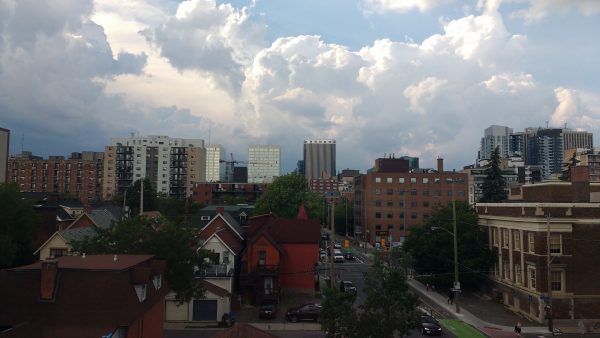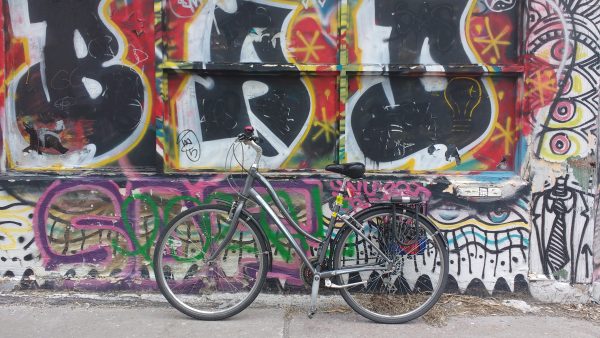Living in Ottawa, it is hard to escape the shadow and allure of Montreal and its near mythic status of urban utopia. After living in Montreal for three years and recently moving back to Ottawa, everyone is eager to hear my Montréalaise reflections on cycling infrastructure and public transit, urban development, activating public space, public art, the art and music scenes. La vérité… it is not really any more of a “city for people” than Ottawa. We can read about cool projects and initiatives, look longingly at photos posted on twitter, and visit them all during a weekend trip to Montreal. That image we construct in bits and pieces does not represent the reality of living there.
As celebrated as Montreal is for its cosmopolitanism, as easy as it is to get by in English, c’est une ville française that tolerates and accommodates but never properly translates into English. Même s’il est possible de ne parler qu’anglais à Montréal, nos interactions quotidiennes entre étrangers, dans la rue, dans les cafés ou au marché, ont de plus en plus naturellement lieu en français. « Salut ! » « Pardon. » « Un café filtre, s’il te plait. » My public life, my street life, now defaults to French.
We make all sorts of divisions between our public life and personal-professional lives. Cities have been organized and planned to reinforce that supposedly natural and logical division. Mais la réalité est un peu plus compliquée. When I started to recognize how my language was getting coded in space, it made sense but it also made me uncomfortable. Je suis universitaire, urbaniste, et activiste. Ma profession est une profession publique. Comment se peut-il que mes espaces soient presque toujours des espaces anglais? How could I live in a French city and learn and write about it in English?
This detour through and reflection on language and the city, has given me perspective on the way Ottawans speak and think of Montreal. In many instances, a key mistranslation occurs when we mistake tourist and entertainment spaces as public spaces. Bien évidemment les résidents profitent des événements et des grands projets mais souvent ces manifestations urbaines perturbent leur vie quotidienne. Par exemple, deux grandes sections de la rue Saint Catherine deviennent des rues piétonnières pendant l’été, mais elles sont surtout destinées aux touristes et aux divertissements : le quartier des spectacles et le village gai.
In Ottawa, we also give streets over to people. Sparks Street was pedestrianized in 1967 and unlike St-Cath, stays that way year-round. Tourists love it. Its generic restaurants and blockbuster events are always packed with people. This is critiqued by Ottawa locals while simultaneously lusting after its Montreal analogue. Montreal supports greater nightlife and attracts more tourists on the street, and maybe does so with greater flair, mais je doute que ce degré de publicité soit vraiment le résultat de la piétonisation.
Il est cependant vrai que les espaces touristiques ne sont pas les seuls où l’on note une plus grande présence publique à Montréal. In the summer, public parks are packed with people using the space in different ways. Parks are not just for sports, kids, and dogs. À Montréal on reçoit souvent un invitation pour une fête, un bbq, un date dans tel ou tel parc. BYOB. People treat parks like a mix of backyards, playgrounds and patios, partly because few people downtown have their own backyard but also because social behaviour is not mistaken for deviant behaviour and regulated.
We do not need to invite internationally acclaimed artist to install a great piece of public art in the park. We do not need designated, corded off adult-only beer gardens or more licensed patios where people can buy $8 beer. Je n’ai rien contre le principe mais ni l’un ni l’autre ne vont recréer la vie publique de Montréal à Ottawa. But both are mistranslations of the urban conditions that contribute to greater social life in public spaces. They try to translate into our own legal and civil ways of constructing public space. Therein lies a problem of lusting after the kind of Montreal urbanism that we see in social media. It tries to translate individual words instead of whole stories. Même si l’on pouvait traduite l’histoire de Montréal à Ottawa, we would get a Montreal without its nuance and lose Ottawa’s own story.
Cities do not translate. Les villes ne se traduisent pas entre langues and cities do not translate from one to another. Too much is lost in translation when we fail to recognize that cities are not just a collection of buildings and streets, they are products of particular histories, cultures, politics, economics, and people. Languages reflect different logics and meanings of space. Both the social construction of public and of government are nuanced differently in Montreal, d’une manière que je ne peux décrire en anglais sans injustice. Nor can I claim to understand the French city, and certainly not a Québecois city. It is not my space to know. Je n’étais qu’une invitée.



3 comments
I speak Korean, Japanese and English but not French.
Could you also post a translated version of your article?
Thanks for your comment, Ichigo.
This article is intended to raise some language politics and questions about who has access to what. Sometimes we just don’t have access to the whole picture.
If you’re really curious and are willing to settle for bad translation and do some work, there’s always google translate.
Great Article. Excellent résumé d’une situation qui ne m’est pas étrangère. I moved from Montréal to Ottawa. After 10 years, I can’t say that I feel at home, is it a barrier language, maybe? Did I say I was Canadien-Français? I also stopped comparing both cities, they are so different in size and culture. Ce que je souhaite par contre, c’est que les citoyens d’Ottawa ce mobilise et reprenne le contôle de leur ville qui trop souvent demeure entre les mains de gestionnaires sans vision et qui propose des projets ne cadrant que trop souvent dans des objectifs de rendements($$$) et dans une logique d’éco-tourisme sans envergure et surtout sans réelle réflexion et sans mesure de l’impact sur le quotidien des riverains. Merci.